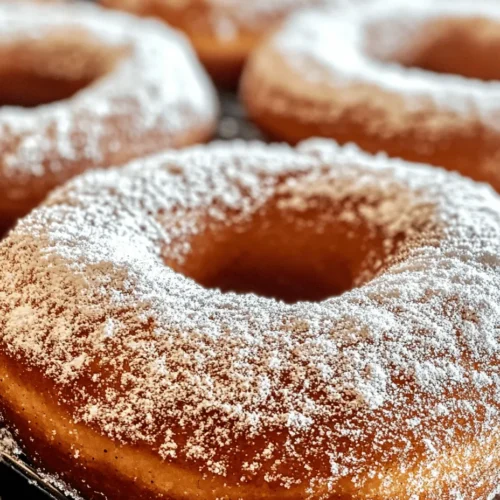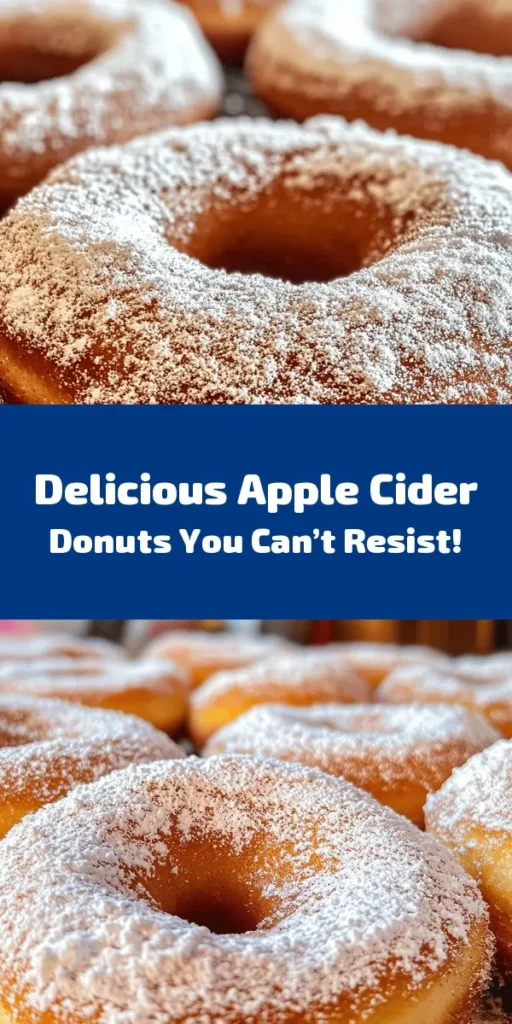Introduction
As the leaves turn golden and the air becomes crisp, the allure of apple cider donuts becomes undeniable. These delightful treats, often found at autumn festivals and local cider mills, have captured the hearts (and taste buds) of many. Their warm, comforting flavors and soft, cake-like texture create an irresistible combination that embodies the essence of fall. The sweet aroma of spices wafting through your kitchen, the anticipation of that first bite, and the joy of sharing these treats with friends and family make baking apple cider donuts a cherished seasonal tradition.
What’s even more delightful is that making these donuts at home is surprisingly simple. With just a few ingredients and some basic baking techniques, you too can enjoy the pleasure of freshly baked apple cider donuts right from your oven. This article will take you on a journey through the history of this beloved treat, provide a detailed breakdown of each ingredient, and guide you through the step-by-step preparation process. So, roll up your sleeves, grab your apron, and let’s dive into the world of apple cider donuts.
Understanding Apple Cider Donuts
The history of apple cider donuts is as rich and layered as the flavors they offer. These sweet treats have roots that trace back to New England, where apple orchards abound and the tradition of cider-making flourished. Early settlers discovered the joys of pressing apples into cider, and as autumn rolled around, utilizing this fresh cider in baked goods became a common practice. The apple cider donut emerged as a popular item in local cider mills, often enjoyed warm and dusted with cinnamon sugar.
Over the years, the recipe for apple cider donuts has evolved from its rustic beginnings. Originally, these donuts were fried, offering a crispy exterior that encased a soft, fluffy interior. However, with the rise of health-conscious baking trends, many home bakers have transitioned to baking these donuts, which still deliver the same comforting flavors without the added oil of frying. Today, apple cider donuts hold a special place not only in American cuisine but also in the hearts of those who savor them.
As the seasons change, the experience of enjoying a warm apple cider donut brings a sense of nostalgia and warmth. Whether it’s a family outing to the orchard or a cozy gathering at home, these donuts evoke memories of crisp autumn days and the simple joys of life. The tradition of baking and sharing apple cider donuts has become a way to celebrate the flavors of fall, making them a must-have treat during this time of year.
Ingredient Breakdown
Before we dive into the step-by-step preparation of apple cider donuts, let’s take a closer look at the essential ingredients that make this recipe come to life. Understanding the role of each component will not only enhance your baking skills but also deepen your appreciation for this seasonal delight.
Apple Cider
At the heart of apple cider donuts is, of course, apple cider. This liquid gold is responsible for infusing the donuts with a rich, fruity flavor that is quintessentially autumn. For the best results, it’s important to use fresh, high-quality apple cider. The process of reducing the cider helps to concentrate its flavors, creating a more robust taste that will shine through in the final product. By simmering the cider until it thickens and reduces, you’ll amplify its natural sweetness and enhance the overall flavor profile of your donuts.
All-Purpose Flour
All-purpose flour serves as the backbone of many baking recipes, and apple cider donuts are no exception. It provides the necessary structure, allowing the donuts to rise and maintain their shape while baking. The right balance of flour ensures that the donuts are soft and tender, creating that perfect bite. For an extra touch of flavor and texture, consider using a blend of all-purpose flour and whole wheat flour, which can add a subtle nuttiness to the final product.
Leavening Agents: Baking Powder and Baking Soda
In order to achieve the desired light and fluffy texture in apple cider donuts, we rely on leavening agents such as baking powder and baking soda. Baking powder works as a chemical leavener, releasing carbon dioxide when it comes into contact with moisture and heat. This reaction helps the donuts rise and creates a soft crumb. Baking soda, on the other hand, requires an acidic component to activate, which in this case comes from the apple cider. The combination of these two leavening agents ensures that your donuts are airy and deliciously tender.
Spices: Cinnamon, Nutmeg, and Allspice
The warm spices used in apple cider donuts play a crucial role in defining their flavor profile. Cinnamon is perhaps the star of the show, adding a familiar warmth that perfectly complements the sweetness of the cider. Nutmeg, with its slightly sweet and nutty flavor, enhances the overall depth of the donuts, while allspice adds a hint of clove and peppery warmth. Together, these spices create a fragrant aroma that fills your kitchen as the donuts bake, making them even more enticing.
Sugars: Granulated and Brown
When it comes to sweetness, a combination of granulated sugar and brown sugar is used in this recipe. Granulated sugar provides the necessary sweetness, while brown sugar adds moisture and a touch of caramel flavor. The molasses content in brown sugar not only enhances the overall taste but also contributes to the rich color of the donuts. This harmonious blend of sugars ensures that every bite is perfectly sweet and satisfying.
Applesauce
Applesauce is a clever addition to apple cider donuts that serves multiple purposes. Not only does it contribute moisture to the batter, keeping the donuts tender, but it also enhances the apple flavor without the need for additional fat. Using unsweetened applesauce allows the natural sweetness of the apples to shine through, making the donuts healthier without sacrificing taste. Plus, it’s an excellent way to incorporate more fruit into your baked goods.
Egg and Vanilla
Eggs are essential in baking as they provide structure and richness to the donuts. When beaten, eggs create air pockets that help the donuts rise, while also contributing to their tender texture. Vanilla extract adds a lovely depth of flavor, complementing the spices and apple cider beautifully. Together, these ingredients create a well-rounded flavor profile that makes each bite of the donut a true delight.
Unsalted Butter
Finally, unsalted butter is a key ingredient that contributes to the flavor and texture of the donuts. Using unsalted butter allows you to control the overall saltiness of the recipe, ensuring a balanced taste. The fat in the butter creates a tender crumb and adds richness to the donuts, resulting in a deliciously satisfying treat. Melting the butter before incorporating it into the batter ensures that it evenly distributes, creating a smooth and cohesive mixture.
Step-by-Step Preparation Guide
Now that we’ve explored the essential ingredients for making irresistible apple cider donuts, it’s time to get into the fun part: the preparation! Follow these detailed steps to create your own batch of warm, comforting apple cider donuts that will fill your home with the delightful scents of fall.
1. Gather Your Ingredients: Begin by assembling all your ingredients on the counter. This will streamline the process and ensure that you don’t miss any key components.
2. Reduce the Apple Cider: In a small saucepan, pour in the apple cider and bring it to a gentle simmer over medium heat. Allow it to simmer for about 15-20 minutes, or until it has reduced by about half. You want the cider to become syrupy and concentrated. Once reduced, set it aside to cool slightly.
3. Preheat the Oven: Preheat your oven to 350°F (175°C). This ensures that your donuts will bake evenly and rise properly.
4. Prepare the Donut Pan: Grease a donut pan with cooking spray or butter to prevent sticking. If you don’t have a donut pan, you can also use a muffin tin, though the shape will be different.
5. Mix Dry Ingredients: In a large mixing bowl, whisk together the all-purpose flour, baking powder, baking soda, cinnamon, nutmeg, allspice, granulated sugar, and brown sugar. Ensure that all the dry ingredients are well combined to avoid any clumps.
6. Combine Wet Ingredients: In a separate bowl, mix together the melted unsalted butter, applesauce, egg, vanilla extract, and the reduced apple cider. Whisk until the mixture is smooth and well blended.
7. Combine Wet and Dry Mixtures: Gently fold the wet ingredients into the dry ingredients, being careful not to overmix. Stir until just combined; a few lumps are perfectly fine. Overmixing can lead to dense donuts, so aim for a light hand.
8. Fill the Donut Pan: Using a piping bag or a spoon, carefully fill each donut cavity in the pan about two-thirds full. This allows enough room for the donuts to rise without overflowing.
9. Bake the Donuts: Place the filled donut pan in the preheated oven and bake for about 10-12 minutes, or until the donuts are golden brown and a toothpick inserted into the center comes out clean. Keep a close eye on them, as baking times may vary depending on your oven.
10. Cool the Donuts: Once baked, remove the donuts from the oven and allow them to cool in the pan for about 5 minutes. Then, gently transfer them to a wire rack to cool completely. This step is crucial for achieving the perfect texture.
With these steps, you’re well on your way to creating a batch of irresistible apple cider donuts that will delight your family and friends. The combination of warm spices, sweet apple flavor, and the joy of baking at home makes this recipe a true celebration of the season. In the next part, we’ll explore some tips for achieving the best results and answer common questions about apple cider donuts. Stay tuned for more delicious insights!

Detailed Instructions on Preparing the Donuts from Start to Finish
Reducing Apple Cider
To achieve the rich, concentrated flavor that defines irresistible apple cider donuts, you must reduce the apple cider. Start with four cups of fresh apple cider. Pour it into a medium saucepan and bring it to a boil over medium-high heat. Once boiling, reduce the heat to medium-low and let it simmer. Stir occasionally, allowing it to reduce to about one cup, which should take approximately 20-30 minutes. The goal is to achieve a syrup-like consistency, which not only intensifies the flavor but also ensures the donuts are moist and flavorful. To check for the right consistency, dip a spoon into the cider; it should coat the back of the spoon. Once reduced, let it cool to room temperature before incorporating it into your batter.
Mixing Dry Ingredients
Proper blending of dry ingredients is vital for achieving an even texture in your donuts. In a large mixing bowl, whisk together two cups of all-purpose flour, three-quarters of a cup of granulated sugar, one tablespoon of baking powder, one teaspoon of baking soda, and half a teaspoon of salt. For added flavor, you can incorporate a teaspoon of ground cinnamon. Ensure there are no lumps by whisking thoroughly. This step is essential as it evenly distributes the leavening agents, which will help your donuts rise uniformly while baking.
Combining Wet Ingredients
In a separate bowl, combine your wet ingredients. Start with the reduced apple cider, adding in two large eggs, one-third of a cup of vegetable oil, and one teaspoon of vanilla extract. Whisk these ingredients together until fully emulsified. Emulsification is the process of mixing ingredients that typically don’t combine well, such as oil and water-based liquids. It creates a smooth batter that ensures even distribution of flavors and moisture throughout the donuts.
Folding Techniques
Folding the wet and dry ingredients together is an art that requires care to avoid overmixing, which can lead to tough donuts. Begin by pouring the wet mixture into the dry ingredients. Using a spatula, gently fold the mixture together, scraping the sides and bottom of the bowl. The goal is to combine the ingredients until just moistened; a few lumps are acceptable. Overmixing will develop the gluten in the flour, leading to denser donuts. Stop mixing as soon as you no longer see dry flour.
Filling the Pan
To achieve the perfect donut shape, you’ll want to fill your donut pan correctly. Lightly grease the pan with cooking spray or butter to prevent sticking. Using a piping bag or a zip-top bag with the corner snipped off, fill each donut cavity about three-quarters full. This allows space for the donuts to rise without overflowing. If you don’t have a piping bag, you can use a spoon, but the piping method provides cleaner edges and a more professional look.
Baking Tips
Preheat your oven to 350°F (175°C), ensuring it reaches the right temperature before placing the donuts inside. Bake for 10-12 minutes or until the donuts are lightly golden and a toothpick inserted in the center comes out clean. Keep an eye on them during the last few minutes of baking, as ovens can vary in temperature. Allow the donuts to cool in the pan for about five minutes before transferring them to a wire rack. Cooling in the pan helps them set and prevents them from breaking apart.
Cooling Process
Proper cooling is crucial for the coating to adhere well. After removing the donuts from the pan, transfer them to a wire rack to cool completely. This allows air to circulate around the donuts, preventing them from becoming soggy. If you attempt to coat them while they are still warm, the coating may slide off rather than stick. Let the donuts cool for at least 15-20 minutes or until they are at room temperature.
Coating and Serving Suggestions
Techniques for Coating Donuts with Powdered Sugar
Coating your donuts with powdered sugar can elevate their appearance and flavor. To do this, place a generous amount of powdered sugar into a shallow bowl. As soon as the donuts have cooled, roll each one in the sugar until fully coated. For a more decadent approach, you can also dip the tops of the donuts in melted butter before rolling them in sugar, creating a delightful, sweet crust.
Tips for Achieving a Perfect Glaze
For a delicious glaze, mix one cup of powdered sugar with two tablespoons of milk and a teaspoon of vanilla extract. Whisk until smooth, adjusting the milk until you reach your desired consistency. For added flavor, consider incorporating spices like cinnamon or nutmeg into your glaze. Dip the tops of each donut into the glaze, allowing any excess to drip off before placing them back on the wire rack. This method not only gives a beautiful finish but also enhances the overall taste of the donuts.
Ideas for Serving
Apple cider donuts pair beautifully with a variety of beverages. Consider serving them alongside a warm cup of coffee or a spiced chai tea for a comforting treat. During the autumn months, you can also offer them with hot apple cider, creating a delightful flavor harmony. For an elegant presentation during gatherings, arrange the donuts on a rustic wooden platter, garnished with fresh apple slices or cinnamon sticks, to capture the essence of fall.
Nutritional Information and Variations
Overview of Nutritional Aspects
Apple cider donuts can be a delicious indulgence, but it’s essential to be mindful of their nutritional aspects. Each donut contains approximately 170 calories, with a balance of carbohydrates, fats, and proteins. While they are a treat, being aware of portion sizes can help keep your indulgence in check.
Suggestions for Healthier Twists
If you’re looking to make your apple cider donuts a bit healthier, consider substituting some of the all-purpose flour with whole wheat flour, which adds fiber and nutrients. Additionally, you can use natural sweeteners like honey or maple syrup in place of granulated sugar to reduce refined sugars. Alternatively, using unsweetened applesauce can also help cut down on sugar while adding moisture.
Creative Variations
Don’t hesitate to experiment with variations! For added texture and flavor, fold in chopped nuts such as walnuts or pecans into the batter. Dried fruits like raisins or cranberries can also provide delightful bursts of sweetness. For a spicier twist, consider adding ginger or allspice to the batter, enhancing the warmth and depth of flavor.
Conclusion
Making apple cider donuts at home is not just about enjoying a delicious treat; it’s about creating a comforting and nostalgic experience that evokes the essence of fall. The process of reducing the cider, mixing the perfect batter, and coating the donuts creates an opportunity for both culinary creativity and cherished moments with family and friends. These donuts serve as a delightful centerpiece for autumn gatherings, inviting everyone to savor the season’s flavors together. So, gather your loved ones, share this recipe, and enjoy the joy of making and indulging in these irresistible apple cider donuts, creating sweet memories that will last well beyond the fall.



